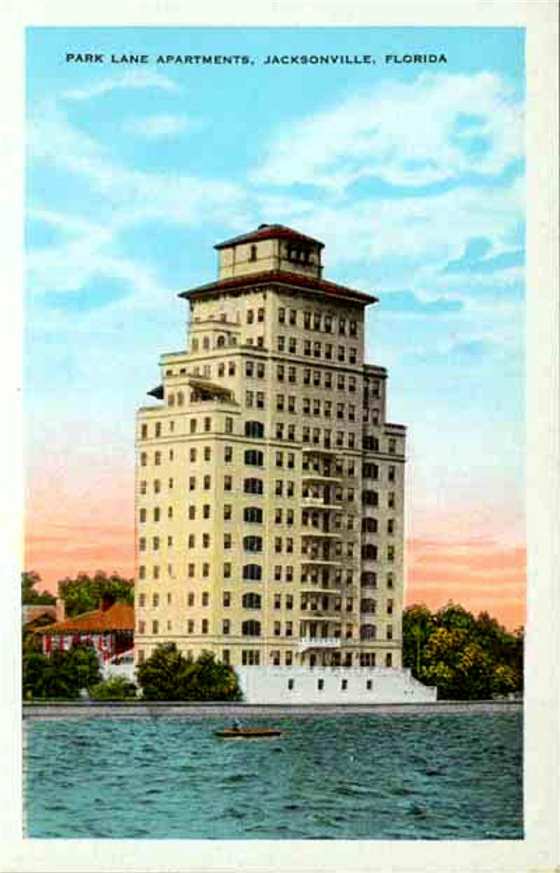- Home
- Florida History
- Florida Heritage Sites
- Miami Beach Holocaust Memorial
MIAMI BEACH HOLOCAUST MEMORIAL
The Holocaust Memorial of the Greater Miami Jewish Federation
1933-1945 Meridian Avenue
Miami Beach, FL 33139
The memorial is open daily from 10:00 AM to sunset, 365 days a year. No admission fee is required, but donations are appreciated.
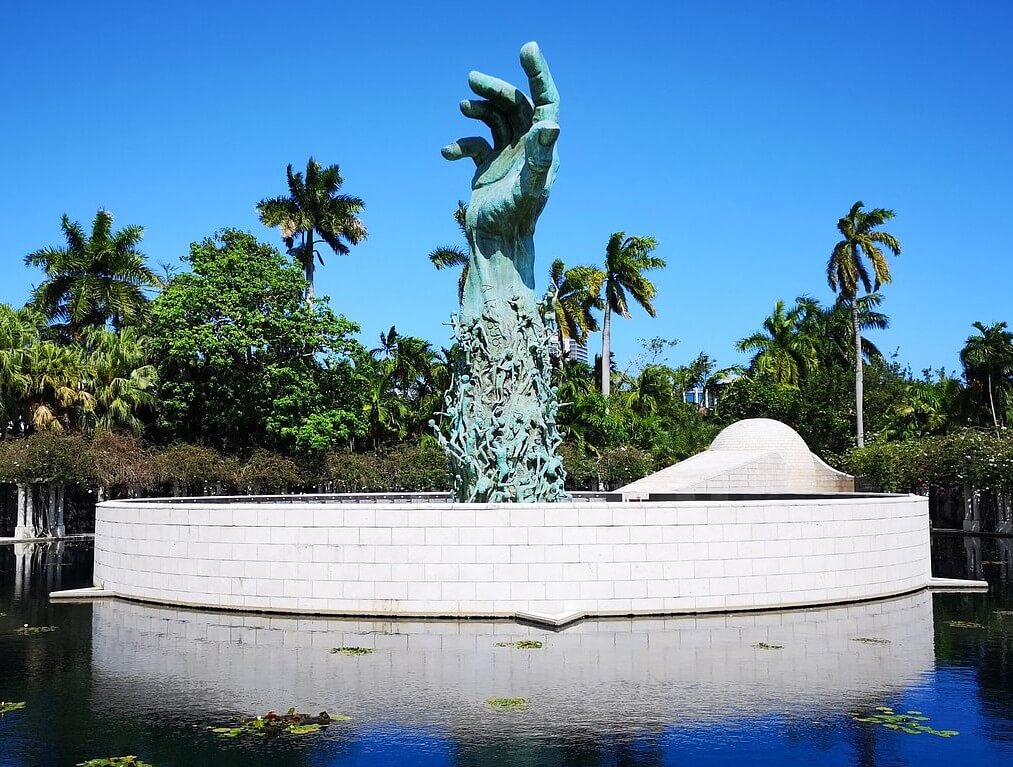 Holocaust Memorial Sculpture
Holocaust Memorial SculptureBy Mike Miller Updated July 27, 2025
This holocaust memorial is an extremely disturbing place to visit. I think that's the way is should be. It honors the victims but also shows the shocking reality of what happened so we never forget.
I am old enough to remember VE Day; the surrender of Germany and its allies marking the end of World War Two in Europe on May 8, 1945.
We didn't have TV in those days; we got our major news from radio, newspapers, or weekly newsreels at the movie theater.
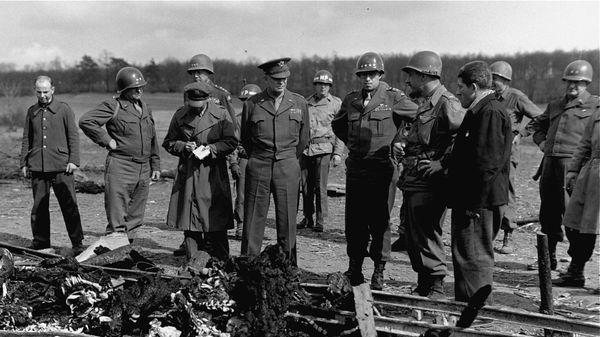 General Eisenhower at Liberated Nazi Camp
General Eisenhower at Liberated Nazi CampOne of the most vivid and sad memories for me is a newsreel of American Generals Eisenhower, Bradley and Patton in a Nazi prison camp standing and looking with sadness and horror at the mass graves of emaciated Jewish prisoners not yet covered up.
There were other photos of dead prisoners stacked like cordwood, some of them partially burned by the Germans who were trying at the last minute to hide evidence of their crimes.
I struggled then and now to understand how some humans can be so cruel and merciless to other human beings.
I may never know the answer, but the various memorials around the world to the Holocaust are necessary to make us remember what can happen.
General Eisenhower ordered that photographs of the camps and bodies be taken and preserved so nobody in the future could suggest it never happened.
EISENHOWER'S OBSERVATIONS OF NAZI CAMP
Supreme Allied Commander Dwight D. Eisenhower understood the scale of the atrocities at Ohrdruf and other concentration camps liberated by the Allies.
He recognized the importance of embedding the true events of the Holocaust deep within the psyche of the international community to ensure the moral balance of WWII could never be forgotten.
From a dispatch to Chairman of the Joint Chiefs of Staff General George C. Marshall, sent immediately after Eisenhower’s visit to Ohrdruf:
“The things I saw beggar description … The visual evidence and the verbal testimony of starvation, cruelty... were so overpowering as to leave me a bit sick. In one room, where they were piled up twenty or thirty naked men, killed by starvation, George Patton would not even enter. He said that he would get sick if he did so. I made the visit deliberately, in order to be in a position to give first-hand evidence of these things if ever, in the future, there develops a tendency to charge these allegations merely to ‘propaganda.’”
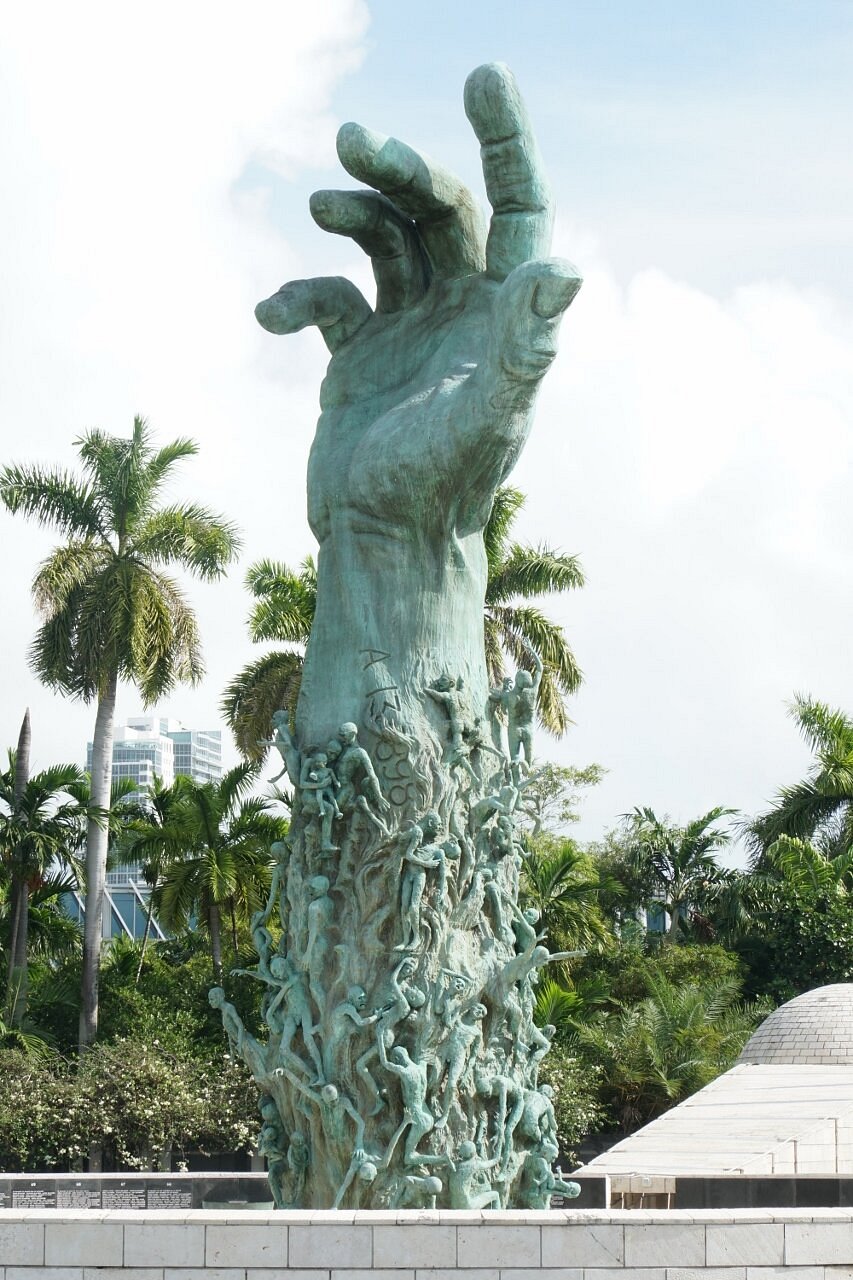 Sculpture of Love and Anguish
Sculpture of Love and AnguishHolocaust Memorial Miami Beach
If you are like me, a visit to this memorial to the holocaust victims will be a haunting, uncomfortable, experience. This is especially true, if like me, you remember it happening.
My aunt Tina was not Jewish, she was a Polish Catholic. She and her husband and two children were imprisoned in separate camps. She never saw them again and married my Uncle Karl many years after the war.
While Jews were the primary targets of the Holocaust, facing systematic genocide, non-Jewish Poles and others suffered immense persecution, with millions killed or displaced.
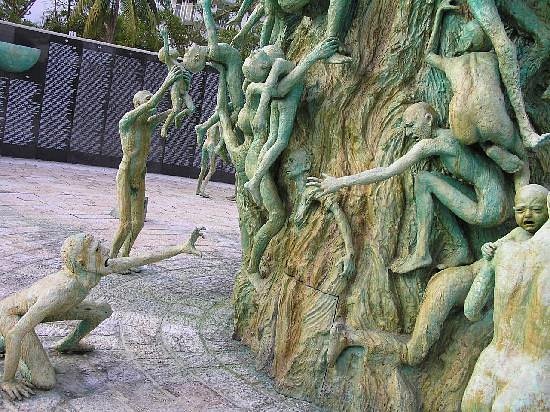 Holocaust Memorial
Holocaust MemorialThe giant hand with desperate clinging people in the Miami Beach Holocaust Memorial, known as the Sculpture of Love and Anguish, is a central and powerful element of the memorial, designed by Kenneth Treister and dedicated in 1990.
This 42-foot bronze sculpture depicts an outstretched arm and hand, tattooed with an Auschwitz number, rising from the ground, with nearly 100 life-sized figures of emaciated Holocaust victims—men, women, and children—clinging to it in various states of anguish, desperation, and mutual support.
 Mother and Child
Mother and ChildThe significance of this imagery can be understood through several key aspects:
SYMBOL OF SUFFERING AND DESPAIR
The hand and figures represent the immense suffering of the six million Jews and other victims of the Holocaust.
Treister described the sculpture as a “scene from hell, frozen in bronze,” capturing the final moments of those facing death in the Nazi camps.
The figures’ tormented expressions and emaciated bodies convey the horror and agony of the Holocaust, evoking a visceral emotional response from visitors.
PLEA FOR SALVATION
The outstretched arm reaching skyward symbolizes a desperate plea for help or salvation, as if appealing to God or humanity for rescue from the atrocities.
The figures climbing the arm, clutching each other, depict families and individuals striving to escape their fate, highlighting the human instinct to survive and protect loved ones even in the face of inevitable doom.
This imagery draws on Auschwitz survivor Primo Levi’s concept of the “drowned and the saved,” reflecting the arbitrary line between those who perished and those who survived.
 Saying Goodbye After A Life Spent Together
Saying Goodbye After A Life Spent TogetherRESILIENCE AND HOPE
Despite the overwhelming tragedy, the hand also embodies the resilience of the human spirit.
Some interpretations see it as a symbol of hope and the enduring strength of survivors, particularly given the memorial’s location in Miami Beach, home after World War Two to a large population of Holocaust survivors.
The upward reach can suggest a triumph of survival and the will to rebuild after unimaginable loss, though this is juxtaposed with the grim reality of the figures’ suffering.
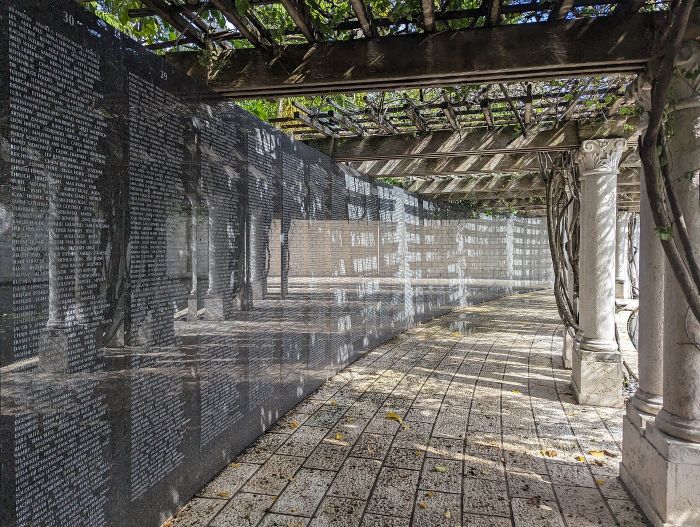 Holocaust Memorial Wall of Names
Holocaust Memorial Wall of NamesMEMORIAL AS A WARNING AND EDUCATIONAL TOOL
The sculpture’s graphic nature serves to confront visitors with the Holocaust’s horrors, ensuring that the memory of the atrocities remains vivid for future generations.
Treister intended the memorial to be an immersive experience, leading visitors through a procession of emotional and historical spaces to prevent forgetting.
The hand, as the focal point, underscores the memorial’s mission to educate and inspire reflection on tolerance and the prevention of such atrocities.
CONTROVERSY AND INTERPRETATION
The sculpture’s stark and grotesque imagery sparked debate, with critics calling it a “brutal intrusion” or arguing it prioritized horror over solemn reflection.
However, Holocaust survivors and committee members, like David Schaecter who spearheaded the creation of the memorial, defended its raw depiction, asserting that the Holocaust’s brutality demanded such an unflinching representation.
The hand’s design was partly inspired by a survivor’s story of losing her hand to Nazi cruelty, symbolizing personal loss and the demand for remembrance.
The woman had been a violinist and her husband a pianist in Poland. The Nazis cut off an arm from each one so they could never perform again.
She spoke at one of the Miami Beach community meetings held to decide if the memorial should be built. Her powerful story helped win the project's approval.
Kenneth Triester is an artist and architect who is the genius behind the design and construction of the Holocaust Memorial. I highly recommend you watch this interview. You will be captivated by his vision, inspiration, and emotion.
The Memorial is Adjacent to Miami Beach Convention Center
The dual addresses of 1933-1945 Meridian Avenue
symbolically reflect the years of the Nazi regime.
LOCATION MAP OF HOLOCAUST MEMORIAL

Florida is the fastest-growing state in the United States and also the fastest-changing. If you see anything in this article that has changed or is in error, please let me know.
Thousands of Florida fans subscribe to our free daily Ezine, Florida Heritage Travel and we have 130,000 followers on Facebook.
By Mike Miller, Copyright 2009-2025
Florida-Back-Roads-Travel.com
Florida Back Roads Travel is not affiliated with or endorsed by Backroads, a California-based tour operator which arranges and conducts travel programs throughout the world.
